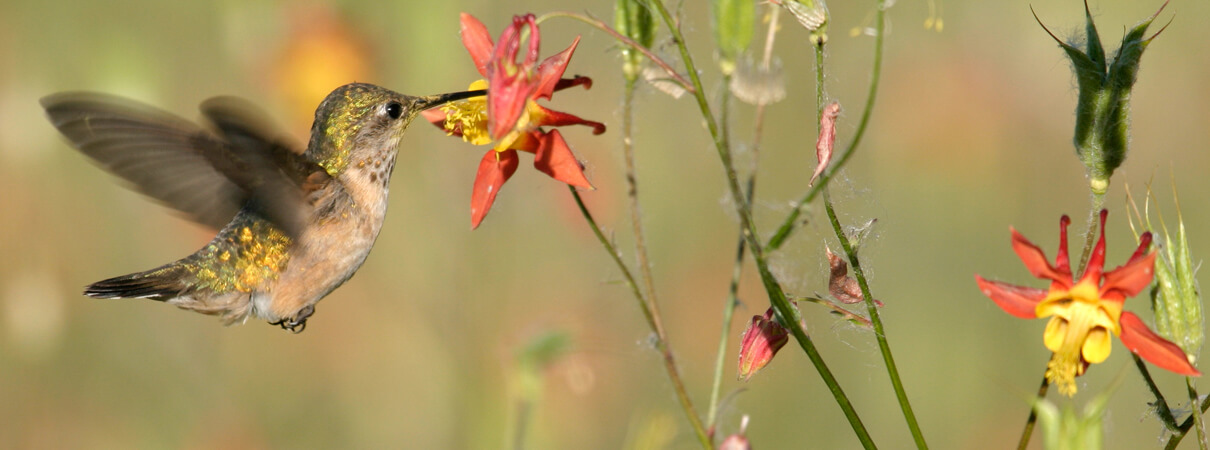 The Calliope Hummingbird is a tiny wonder – at only around 3 inches long, it's the smallest breeding bird in Canada and the United States, and the smallest long-distance migratory bird in the world.
The Calliope Hummingbird is a tiny wonder – at only around 3 inches long, it's the smallest breeding bird in Canada and the United States, and the smallest long-distance migratory bird in the world.
This indomitable mite migrates as far as 5,600 miles from the western United States and Canada, where it shares its montane breeding habitat with the Rufous Hummingbird, to wintering grounds in southern Mexico. In winter, it's often found in areas sheltering Townsend's Warbler, Varied Bunting, and other migratory birds.
This small hummingbird takes its name from Calliope, one of the Muses of Greek mythology, who represented eloquence and epic poetry. Calliope means “beautiful voiced” in ancient Greek. But since the Calliope Hummingbird has an unmelodic song typical of hummingbirds, the name is a bit of a mystery!
Staying Out of Sight
Adult male Calliope Hummingbirds can be identified by their long purplish-red gorget (throat) feathers, which appear as stripes accented with white, and look whisker-like when fluffed out. Females and immatures closely resemble female Rufous and Allen's Hummingbirds, but the latter species are slightly larger, with more contrasting markings and longer tails.
The tiny Calliope is often chased by larger hummingbirds, particularly the more aggressive Rufous Hummingbird. It tends to stay quiet and inconspicuous outside of the breeding season, perching and foraging closer to the ground than other hummingbird species, perhaps in order to escape notice.
Spectacular Displays
Like most hummingbirds, male Calliopes are highly territorial during their breeding season. A male will stake out and defend territory with aerial displays, flying as high as 100 feet and descending in a series of U-shaped dives. At the bottom of each dive, he makes a metallic pzzt-zing sound, a combination of voice and specialized flight feathers.
When a female Calliope Hummingbird perches within his territory, the resident male swings into courtship mode, hovering in front of his potential mate with iridescent throat feathers spread into a shining starburst. He also makes a loud buzzing noise during this flashy display. If the female is suitably impressed, she leaves her perch and joins the male in an aerial dance, with both birds circling each other, sometimes even clasping bills.
Mountain Nester
Calliope Hummingbirds do not form extended pair bonds, which is true for other Ruby-throated and other hummingbird species as well. Once mated, the female builds her nest, incubates the eggs, and feeds the young on her own. The tiny nest of lichens, moss, and spider webs is usually built in a conifer, at the base of a cone or tree knot, and is so well-camouflaged that it is often mistaken for a cone!
Females often steal nesting materials from other birds' nests while building their own, and may even refurbish and use a previous year's nest that survived the winter.

Female Calliope Hummingbird feeding on columbine flowers. Photo by Robert Mutch, Shutterstock
Like others in its family, the Calliope Hummingbird feeds on nectar from both flowers and artificial feeders; sap from sapsucker wells; and insects captured in flight. This species begins migrating to its wintering areas earlier than most hummingbirds, feeding on summer-blooming flowers along the way.
Calliope Conservation
Although Partners in Flight data shows slight population declines, most likely due to habitat loss, the Calliope Hummingbird remains widespread and fairly common. Much remains unknown about its life history, however, and this species may be especially vulnerable to land-use changes on its rather small wintering range in Mexico.
ABC's BirdScapes approach to migratory bird conservation helps Neotropical migrants such as the Calliope Hummingbird by protecting essential wintering habitat.
Donate to support ABC's conservation mission!



















































